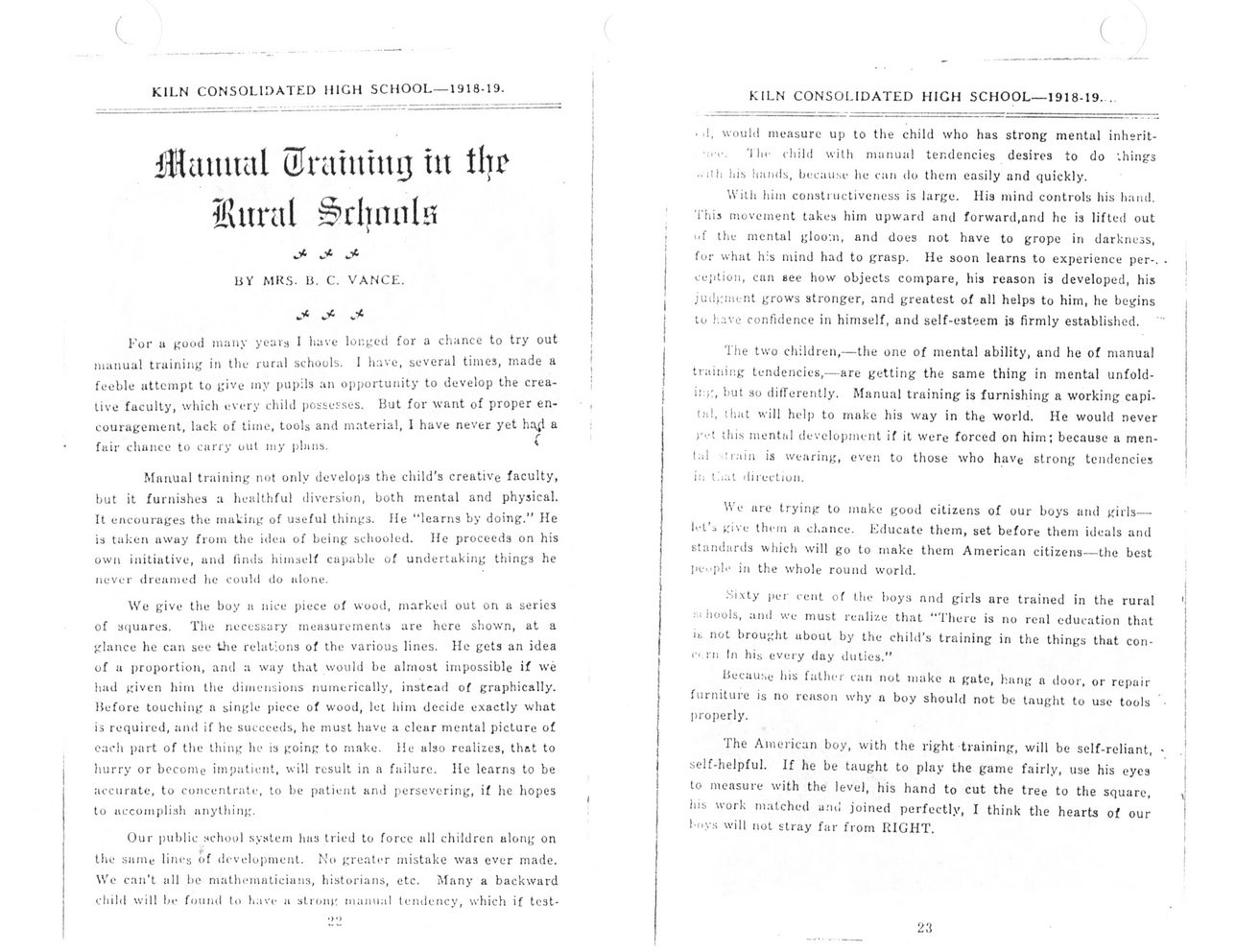This text was obtained via automated optical character recognition.
It has not been edited and may therefore contain several errors.
( KILN CONSOLIDATED MICH SCHOOL—1918-19. iHmtual (Framhuj tit the Bxtinil ^rlimihi jf. _■* j. 11V MRS. B. C. VANCE. > J- 1'or u good many years I have longed for a chance to try out manual training in the rural schools. I have, several times, made a feeble attempt to give mv pupils an opportunity to develop the creative faculty, which every child possesses. But for want of proper encouragement, lack of time, tools and material, 1 have never yet hajl a fair chance to carry out my plans. 1 Manual training not only develops the child’s creative faculty, but it furnishes a healthful diversion, both mental and physical. It encourages the making of useful things. He “learns by doing.” He is taken awuy from the idea of being schooled. He proceeds on his own initiative, and finds himself capable of undertaking things he never dreamed he could do ulone. We give the boy a nice piece of wood, marked out on a series of squares. The necessary measurements are here shown, at a glance he can see the relations of the various lines. He gets an idea of a proportion, and a way that would be almost impossible if wc had given him the dimensions numerically, instead of graphically. Before touching a single piece of w'ood, let him decide exactly what is required, and if he succeeds, he must have a clear mental picture of each part of the thing he is going to make. He also realizes, that to hurry or become impatient, will result in a failure. He learns to be accurate, to concentrate, to be patient and persevering, if he hopes to accomplish anything. Our public school system lias tried to force all children along on the same lines of development. No greater mistake was ever made. We can’t all he mathematicians, historians, etc. Many a backward child will be found to have a stroni' manual tendency, which if test- ♦>«> KILN CONSOLIDATED HIGH SCHOOL—1918-19. . .1, would measure up to the child who has strong mental inherit-:'i'. The child with manual tendencies desires to do ‘.hings .. iih his hands, because he can do them easily and quickly. With him constmctiveness is large. His mind controls his hand. This movement takes him upward and forward,and he is lifted out wf the mental gloom, and does not have to grope in darkness, for what his mind had to grasp. He soon learns to experience per-, coption, can see how objects compare, his reason is developed, his judgment grows stronger, and greatest of all helps to him, he begins to have confidence in himself, and self-esteem is firmly established. The two children,—the one of mental ability, and he of manual training tendencies,—are getting the same thing in mental unfold- ii ;:, but so differently. Manual training is furnishing a working capital, that will help to make his way in the world. He would never get this mental development if it were forced on him; because a mental train is wearing, even to those who have strong tendencies in t'i^l direction. We are trying to make good citizens of our boys and girls— let’j give them a chance. Kducate them, set before them ideals and standards which will go to make them American citizens—the best people in the whole round world. Sixty per cent of the boys and girls are trained in the rural : > hools, and we must realize that “There is no real education that it, not brought about by the child’s training in the things that concern In his every day duties." Because his father can not make a gate, hang n door, or repair furniture is no reason why n boy should not be taught to use tools properly. The American boy, with the right training, will be self-reliant, self-helpful. If he be taught to play the game fairly, use his eyes to measure with the level, his hand to cut the tree to the square, Ins work matched and joined perfectly, I think the hearts of our boys will not stray far from RIGHT.

Kiln History Document (074)